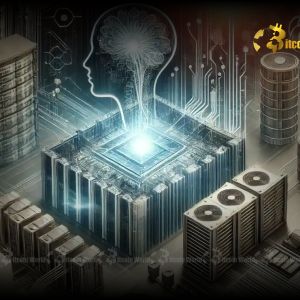Meta’s Colossal AI Data Center: A 5GW Power Play
7 min read
BitcoinWorld Meta’s Colossal AI Data Center: A 5GW Power Play The cryptocurrency world often intersects with groundbreaking technological advancements, and Meta’s latest announcement is no exception. As digital assets increasingly rely on robust infrastructure and powerful computing, the news that Meta is constructing a colossal AI data center , dubbed Hyperion, sends ripples through the tech and energy sectors alike. This ambitious project aims to deliver an astounding five gigawatts of computational power, marking a significant escalation in the global artificial intelligence race. For anyone following the rapid evolution of AI and its foundational needs, understanding Meta’s move is crucial, as it foreshadows the immense infrastructure demands that will shape our technological future. Meta’s Ambitious Hyperion Project: Powering the Future of AI Mark Zuckerberg, CEO of Meta, recently revealed the company’s monumental undertaking: the development of Hyperion, an AI data center designed to be a cornerstone of its new artificial intelligence laboratory. This facility is projected to provide an unprecedented five gigawatt power capacity, a figure that underscores the sheer scale of modern AI training requirements. To put this into perspective, five gigawatts is an immense amount of electricity, capable of powering millions of homes. The announcement highlights Meta’s aggressive strategy to gain a competitive edge against industry titans like OpenAI and Google in the fiercely contested AI landscape. Meta’s commitment to this endeavor is not just about hardware; it’s also about talent. The company has strategically brought on board top minds to lead its Meta Superintelligence Lab. This includes individuals such as Alexandr Wang, formerly CEO of Scale AI, and Daniel Gross, who previously led Safe Superintelligence. The combination of elite talent and a massive computational infrastructure positions Meta to make significant strides in developing sophisticated frontier AI models . The company recognizes that groundbreaking AI innovation requires not only brilliant minds but also an unparalleled capacity for data processing and model training. Zuckerberg further elaborated on the sheer physical footprint of Hyperion, noting its size will be comparable to most of Manhattan. This comparison vividly illustrates the enormous scale of the facility, emphasizing the extensive resources required to house and operate such a powerful computing hub. Beyond Hyperion, Meta also plans to bring another significant supercluster, named Prometheus, online by 2026. Prometheus is slated to provide one gigawatt of power, further solidifying Meta’s position as one of the pioneering tech companies to deploy such immense computational resources. These investments collectively signal Meta’s determination to lead the charge in AI development, ensuring it has the foundational capabilities to train and deploy the most advanced AI systems. Why the Push for Unprecedented Gigawatt Power? The race to develop advanced artificial intelligence is fundamentally a race for computational power. Training frontier AI models , especially large language models (LLMs) and complex generative AI systems, demands extraordinary processing capabilities. These models learn from vast datasets, requiring billions, if not trillions, of parameters to be adjusted and optimized through iterative training cycles. Each cycle consumes immense computational resources, translating directly into a need for massive electrical power. Meta’s investment in five gigawatt power for Hyperion is a direct response to this escalating demand. The benefits of possessing such a powerful infrastructure are manifold. Firstly, it allows Meta to iterate on its AI models much faster than competitors with less computational muscle. This speed is critical in a rapidly evolving field where incremental improvements can lead to significant breakthroughs. Secondly, it enables Meta to train models of unprecedented scale and complexity, potentially unlocking new capabilities and applications that are currently beyond reach. This could include more sophisticated conversational AI, highly realistic content generation, or advanced scientific discovery tools. Thirdly, having dedicated, immense computational power reduces reliance on external cloud providers, offering greater control, security, and potentially cost efficiency in the long run. Furthermore, this infrastructure serves as a powerful magnet for top-tier AI talent. Researchers and engineers are often drawn to organizations that can provide them with the tools and resources necessary to push the boundaries of AI. The opportunity to work with a five-gigawatt supercomputer like Hyperion is a compelling proposition for those looking to make a significant impact in the field. This symbiotic relationship between infrastructure and talent is crucial for Meta’s long-term success in the AI domain, ensuring it remains at the forefront of innovation. The Environmental Impact: Is AI Energy Consumption Sustainable? While the technological ambitions behind Meta’s AI data center projects are undeniable, they come with significant environmental implications, particularly concerning AI energy consumption . The combined power needs of Hyperion and Prometheus alone will be enough to supply millions of homes, raising serious questions about the sustainability of such massive energy demands. The reliance on traditional energy sources for these data centers could place considerable strain on existing power grids and local communities. One tangible example of this impact has already emerged. A Meta data center project in Newton County, Georgia, reportedly led to water taps running dry in some residential areas, as reported by The New York Times. This incident highlights a critical, often overlooked aspect of data center operations: their substantial water requirements for cooling. As AI data centers grow in size and power, their demand for water for cooling systems will also escalate, potentially exacerbating water scarcity issues in drought-prone or water-stressed regions. The issue is not unique to Meta. Other major players in the AI hyperscaler space are facing similar challenges. CoreWeave, another significant AI infrastructure provider, is planning an expansion that is projected to double the electricity needs of a city near Dallas, Texas, according to Bloomberg. These examples underscore a broader trend: the insatiable appetite of AI for energy and resources. Experts estimate that by 2030, data centers could account for a staggering 20% of America’s energy consumption, a dramatic increase from just 2.5% in 2022. Without a rapid and substantial increase in renewable energy production, this trajectory could lead to significant environmental strain and resource conflicts. Addressing the environmental footprint of AI is becoming a paramount concern. Solutions could include: Renewable Energy Integration: Prioritizing the use of solar, wind, and geothermal energy to power data centers. Advanced Cooling Technologies: Developing more efficient cooling systems that reduce water consumption, such as liquid cooling or air-side economizers. Location Strategy: Building data centers in regions with abundant renewable energy sources and sustainable water supplies. Energy Efficiency: Optimizing AI models and hardware for greater computational efficiency, reducing the energy required per computation. The balance between technological advancement and environmental responsibility will be a defining challenge for the AI industry in the coming years. The Broader AI Race and Government Support Meta’s massive investment in its AI data center infrastructure is part of a larger, global AI arms race involving the world’s leading technology companies. Beyond Meta, other notable efforts include OpenAI’s “Stargate” project, a collaboration with Oracle and Softbank, which is also envisioned as a colossal supercomputing facility. Similarly, Elon Musk’s xAI is developing its “Colossus” supercomputer, demonstrating a shared understanding among tech leaders that immense computational power is the key to unlocking the next generation of AI capabilities. Interestingly, this push for vast AI infrastructure has garnered significant support from governmental bodies. The Trump administration, for instance, has largely championed the tech industry’s AI data center buildout. Former President Donald Trump himself helped announce OpenAI’s Stargate project, signaling a federal endorsement of expanding America’s AI infrastructure. This bipartisan interest in AI development is further evidenced by statements from current officials. U.S. Secretary of Energy Chris Wright, in a column for The Economist, articulated a vision for the U.S. to “lead the next major energy-intensive frontier: artificial intelligence.” He highlighted AI’s unique ability to transform electricity into “the most valuable output imaginable: intelligence.” Wright’s comments also indicated a federal commitment to accelerating energy production from various sources, including coal, nuclear, geothermal, and natural gas, to meet the burgeoning demands of the AI sector. This governmental backing suggests that the AI industry is poised to consume a substantial portion of America’s energy output in the foreseeable future, potentially reshaping national energy policies and infrastructure priorities. The implications of this coordinated effort between tech giants and government are profound. It suggests a future where computational power becomes a strategic national asset, akin to natural resources or military capabilities. The ability to train and deploy cutting-edge frontier AI models will not only drive economic growth but also influence geopolitical standing. However, this also intensifies the urgency to address the associated environmental challenges, ensuring that the pursuit of intelligence does not come at an unsustainable cost to the planet. What Does This Mean for the Future of Technology and Energy? Meta’s ambitious Meta AI data center projects, Hyperion and Prometheus, represent a critical inflection point in the development of artificial intelligence. By committing to five gigawatt power capacity, Meta is not just building infrastructure; it’s laying the groundwork for a future where AI capabilities are vastly expanded and integrated more deeply into our lives. This immense investment signals a firm belief that the next generation of technological breakthroughs will be driven by powerful AI, requiring computational resources far beyond what is currently common. The scale of these projects also brings to the forefront the pressing need for sustainable energy solutions. As AI energy consumption continues its exponential rise, innovation in renewable energy, energy efficiency, and grid management will become paramount. The challenges faced by communities near these data centers, such as water scarcity, underscore the importance of responsible development and transparent engagement with local stakeholders. The conversation around AI must expand beyond its capabilities to include its ecological footprint and societal impact. Ultimately, Meta’s Hyperion and Prometheus initiatives are powerful indicators of the direction in which the technology world is heading. They are a testament to the belief that AI will redefine industries, create new economic opportunities, and solve complex global challenges. However, they also serve as a stark reminder that this progress must be carefully managed to ensure it is sustainable and equitable. The future of AI is not just about intelligence; it’s about responsible power. To learn more about the latest AI market trends, explore our article on key developments shaping AI Models features. This post Meta’s Colossal AI Data Center: A 5GW Power Play first appeared on BitcoinWorld and is written by Editorial Team

Source: Bitcoin World



